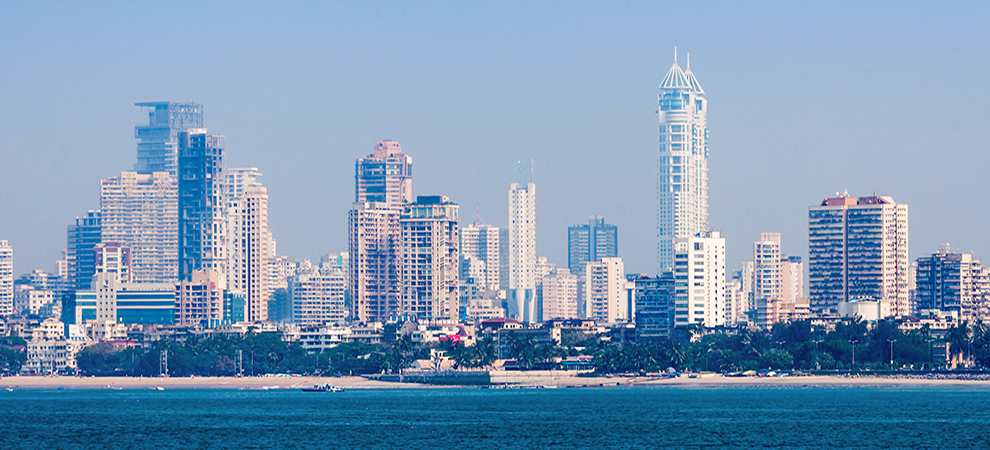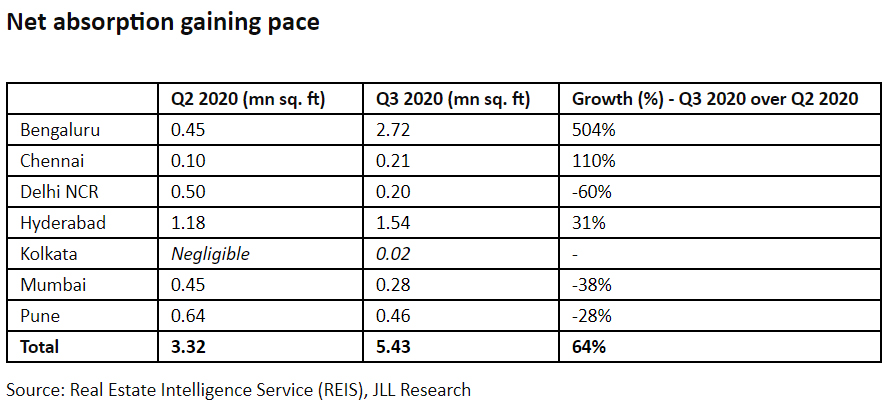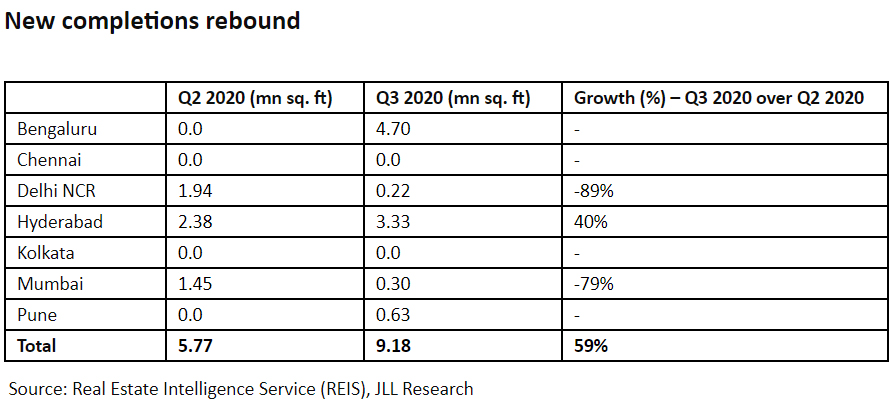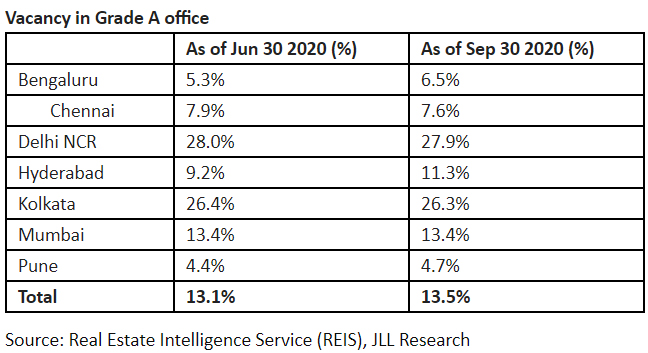The WPJ
THE WORLD PROPERTY JOURNALReal Estate Facts Not Fiction
Commercial Real Estate News

India's Office Market Rebounding in Q3 from COVID-19 Downturn
Commercial News » Mumbai Edition | By Michael Gerrity | October 6, 2020 9:00 AM ET
According to new data by JLL Research, India's office market witnessed a net absorption of 5.4 million sq. ft in quarter ending September 2020 (Q3), an increase of 64% versus quarter ending June 2020 (Q2). This is an encouraging trend especially after net absorption dipped almost at a similar rate in the second quarter.
The third quarter office rebound growth was led by Bengaluru and Hyderabad, which together accounted for nearly 80% of the net absorption in Q3 2020. The heightened activity in Bengaluru indicates a gradual resurgence in take up of spaces coupled with the translation of pent up demand from Q2 this year.

"While we continue to see the impact of the pandemic on various businesses, there is a significant surge in activity across most office markets under consideration. This is seen in gross leasing which more than doubled from the previous quarter at 13.8 million sq. ft. At the same time, it is important to note that large and mid-sized occupiers across major markets continue to review their real estate portfolios in a bid to optimize cost, higher emphasis is being given on sustainability and employee well-being as well as adoption of flexible working practices." said Ramesh Nair, CEO and Country Head, India, JLL.
While the share of IT/ITeS occupiers in gross leasing dipped to 43% in Q3 2020 from 61% in Q2 2020, e-commerce and manufacturing sectors gained significant shares during the third quarter forming 16% (negligible in Q2 2020) and 17% (5% in Q2 2020) respectively, owing to surging demand of e-commerce during COVID19.
Confidence in new completions
New completions during Q3 2020 increased by 59% quarter-on-quarter with 9.2 million sq. ft of new stock coming to market. "With lockdown restrictions being relaxed in the third quarter in most of the markets under review, office projects in the final stages of construction or pending receipt of occupancy certificates came onboard. This resulted in an increase in the supply of office space, even surpassing 8.6 million sq. ft witnessed in Q1 2020," said Dr. Samantak Das, Chief Economist and Head of Research & REIS, India, JLL.

In sync with net absorption, Bengaluru and Hyderabad led the increase in new completions accounting for 87% of the total new completions in Q3 2020. Notably, new completions in both these markets even went past the average new completion levels witnessed in the four quarters of 2019.
Vacancies go up in Grade A offices
Increased office space consolidation and optimization strategies of corporate occupiers resulted in subdued net absorption levels, which could not keep pace with new completions. This resulted in overall vacancy increasing from 13.1% in Q2 2020 to 13.5% in Q3 2020. Despite the rise in vacancy levels in southern markets, Bengaluru, Chennai and Pune continued to hover in single digits. This augurs well for a strong rebound in these markets when economic and business conditions improve in the coming quarters.

Rentals across markets remain stable
Except for Bengaluru, which witnessed a marginal increase in rents, office rents in Q3 2020 vs. Q2 2020 remained stable across all markets under review. With stable rental values and low vacancy levels, the office market in India continues to be landlord favorable. However, it is important to note that landlords across markets have become more flexible in providing increased rent-free periods, reduced rental escalation and fully furnished deals to prominent occupiers, which reduces their net outgo.
The third quarter office rebound growth was led by Bengaluru and Hyderabad, which together accounted for nearly 80% of the net absorption in Q3 2020. The heightened activity in Bengaluru indicates a gradual resurgence in take up of spaces coupled with the translation of pent up demand from Q2 this year.

"While we continue to see the impact of the pandemic on various businesses, there is a significant surge in activity across most office markets under consideration. This is seen in gross leasing which more than doubled from the previous quarter at 13.8 million sq. ft. At the same time, it is important to note that large and mid-sized occupiers across major markets continue to review their real estate portfolios in a bid to optimize cost, higher emphasis is being given on sustainability and employee well-being as well as adoption of flexible working practices." said Ramesh Nair, CEO and Country Head, India, JLL.
While the share of IT/ITeS occupiers in gross leasing dipped to 43% in Q3 2020 from 61% in Q2 2020, e-commerce and manufacturing sectors gained significant shares during the third quarter forming 16% (negligible in Q2 2020) and 17% (5% in Q2 2020) respectively, owing to surging demand of e-commerce during COVID19.
Confidence in new completions
New completions during Q3 2020 increased by 59% quarter-on-quarter with 9.2 million sq. ft of new stock coming to market. "With lockdown restrictions being relaxed in the third quarter in most of the markets under review, office projects in the final stages of construction or pending receipt of occupancy certificates came onboard. This resulted in an increase in the supply of office space, even surpassing 8.6 million sq. ft witnessed in Q1 2020," said Dr. Samantak Das, Chief Economist and Head of Research & REIS, India, JLL.

In sync with net absorption, Bengaluru and Hyderabad led the increase in new completions accounting for 87% of the total new completions in Q3 2020. Notably, new completions in both these markets even went past the average new completion levels witnessed in the four quarters of 2019.
Vacancies go up in Grade A offices
Increased office space consolidation and optimization strategies of corporate occupiers resulted in subdued net absorption levels, which could not keep pace with new completions. This resulted in overall vacancy increasing from 13.1% in Q2 2020 to 13.5% in Q3 2020. Despite the rise in vacancy levels in southern markets, Bengaluru, Chennai and Pune continued to hover in single digits. This augurs well for a strong rebound in these markets when economic and business conditions improve in the coming quarters.

Rentals across markets remain stable
Except for Bengaluru, which witnessed a marginal increase in rents, office rents in Q3 2020 vs. Q2 2020 remained stable across all markets under review. With stable rental values and low vacancy levels, the office market in India continues to be landlord favorable. However, it is important to note that landlords across markets have become more flexible in providing increased rent-free periods, reduced rental escalation and fully furnished deals to prominent occupiers, which reduces their net outgo.
Sign Up Free | The WPJ Weekly Newsletter
Relevant real estate news.
Actionable market intelligence.
Right to your inbox every week.
Real Estate Listings Showcase
Related News Stories
Commercial Real Estate Headlines
- Investment in Asia Pacific Multifamily Properties to Double by 2030
- Multi-story Warehouses Are 15 Percent of Sydney's New Industrial Stock
- Manhattan Office Leasing Activity Lags in Q3 as Sentiment Remains Cautious
- Nonresidential Construction Spending Increases in America
- Office Conversions on Pace to Double in U.S.
- Hong Kong Office Vacancy Rates Stabilize After 4 Months of Increases
- Commercial Mortgage Debt Outstanding in U.S. Jumps to $4.60 Trillion in Mid 2023
- Architecture Billings Index in U.S. Remains Flat in July
- Commercial Mortgage Delinquencies Rise in America
- U.S. Data Center Demand Explodes in U.S., Driven by AI Growth in 2023
- Demand for Electric Vehicle Manufacturing Space Jumps Across the U.S.
- Global Cross Border Commercial Property Capital Flows Implode 52 Percent Annually in 2023
- 2023 Financing Constraints Rapidly Drive Down Construction Starts in U.S.
- New York City Named as U.S. Leader in Climate Change Resilience
- Tokyo is the City of Choice for Global Retailers in 2023
- Despite VC Cooldown, Life Sciences Represents 33 Percent of New Office Construction in 2023
- Despite Reduced Credit, U.S. Multifamily Developer Confidence Remained Positive in Q2
- Brisbane Office Market Enjoying Strong Leasing Activity in 2023
- Commercial Lending Dampened in 2023 by U.S. Market Uncertainty
- Asia Pacific's Commercial Investment Market Continues to be Challenged in 2023
- Despite Global Economic Uncertainty, Commercial Investment in Japan Grew in Q2
- U.S. Commercial Lending to Dive 38 Percent to $504 Billion in 2023
- Apartment Markets Across America Continue to Stabilize in 2023
- Cap Rates for Prime Multifamily Assets in U.S. Stabilize in Q2
- Ireland Office Market Making a Comeback in 2023
- U.S. Office Sales Total $15 Billion Halfway Through 2023
- AI and Streaming Drive Global Data Center Growth Despite Power Constraints
- Asia Pacific Logistics Users Plan to Expand Warehouse Portfolio in 2023
- Manhattan Retail Rents Continue to Rise in Q2
- Manhattan Office Leasing Activity Down 29 Percent Annually in Q2
- Commercial Property Investment in Australia Dives 50 Percent in 2023
- U.S. Architecture Billings Uptick in May
- Employees Return to Office Trend Growing in Asia Pacific Markets
- Exponential AI Growth to Drive Asia Pacific's Data Center Market
- Large Opportunity to Transform Australia's Office Market in Play
- Australian Industrial Rent Growth to Continue in 2023
- Corporate Relocations in U.S. at Highest Rate Since 2017
- North American Ports Volume Drops 20 Percent Annually in 2023
- Office Investment in Asia Pacific Remains Strong Despite Weaker Sentiment
- Australia's Build-to-Rent Properties Uptick on Lender's Wish List in 2023
Reader Poll
Marketplace Links
This website uses cookies to improve user experience. By using our website you consent in accordance with our Cookie Policy. Read More





